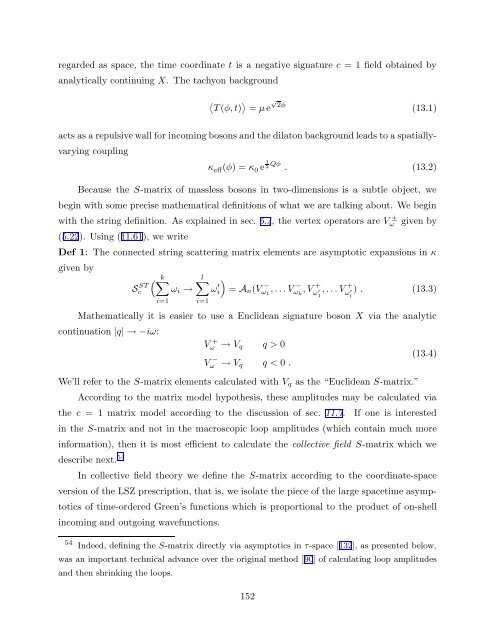arXiv:hep-th/9304011 v1 Apr 5 1993
arXiv:hep-th/9304011 v1 Apr 5 1993
arXiv:hep-th/9304011 v1 Apr 5 1993
Create successful ePaper yourself
Turn your PDF publications into a flip-book with our unique Google optimized e-Paper software.
egarded as space, <strong>th</strong>e time coordinate t is a negative signature c = 1 field obtained by<br />
analytically continuing X. The tachyon background<br />
〈<br />
T (φ, t)<br />
〉<br />
= µ e<br />
√<br />
2φ<br />
(13.1)<br />
acts as a repulsive wall for incoming bosons and <strong>th</strong>e dilaton background leads to a spatiallyvarying<br />
coupling<br />
κ eff (φ) = κ 0 e 1 2 Qφ . (13.2)<br />
Because <strong>th</strong>e S-matrix of massless bosons in two-dimensions is a subtle object, we<br />
begin wi<strong>th</strong> some precise ma<strong>th</strong>ematical definitions of what we are talking about. We begin<br />
wi<strong>th</strong> <strong>th</strong>e string definition. As explained in sec. 5.4, <strong>th</strong>e vertex operators are V ± ω<br />
(5.22). Using (11.61), we write<br />
given by<br />
Def 1: The connected string scattering matrix elements are asymptotic expansions in κ<br />
given by<br />
S ST<br />
c<br />
( k∑<br />
ω i →<br />
i=1<br />
l∑<br />
i=1<br />
ω ′ i<br />
)<br />
= A n (Vω − 1<br />
, . . . Vω − k<br />
, V + ω<br />
, . . . V +<br />
1<br />
′ ω<br />
) . (13.3)<br />
′<br />
l<br />
Ma<strong>th</strong>ematically it is easier to use a Euclidean signature boson X via <strong>th</strong>e analytic<br />
continuation |q| → −iω:<br />
V + ω → V q q > 0<br />
V − ω → V q q < 0 .<br />
(13.4)<br />
We’ll refer to <strong>th</strong>e S-matrix elements calculated wi<strong>th</strong> V q as <strong>th</strong>e “Euclidean S-matrix.”<br />
According to <strong>th</strong>e matrix model hypo<strong>th</strong>esis, <strong>th</strong>ese amplitudes may be calculated via<br />
<strong>th</strong>e c = 1 matrix model according to <strong>th</strong>e discussion of sec. 11.7. If one is interested<br />
in <strong>th</strong>e S-matrix and not in <strong>th</strong>e macroscopic loop amplitudes (which contain much more<br />
information), <strong>th</strong>en it is most efficient to calculate <strong>th</strong>e collective field S-matrix which we<br />
describe next. 54<br />
In collective field <strong>th</strong>eory we define <strong>th</strong>e S-matrix according to <strong>th</strong>e coordinate-space<br />
version of <strong>th</strong>e LSZ prescription, <strong>th</strong>at is, we isolate <strong>th</strong>e piece of <strong>th</strong>e large spacetime asymptotics<br />
of time-ordered Green’s functions which is proportional to <strong>th</strong>e product of on-shell<br />
incoming and outgoing wavefunctions.<br />
54 Indeed, defining <strong>th</strong>e S-matrix directly via asymptotics in τ-space [132], as presented below,<br />
was an important technical advance over <strong>th</strong>e original me<strong>th</strong>od [90] of calculating loop amplitudes<br />
and <strong>th</strong>en shrinking <strong>th</strong>e loops.<br />
152
















